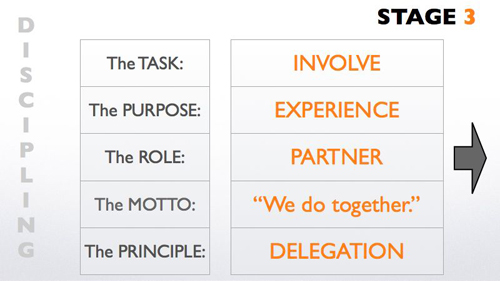Stage Three - Involve
Series | Making Disciples
The practical plan of discipleship starts with instruction and includes living illustration. In Stage Three the disciple develops even further toward becoming a discipler.

Teaching biblical doctrine and demonstrating how to follow Christ is fundamental to making disciples. But that’s not all we can do. Since we also want our disciple to make disciples of his or her own we must bring them in to the process. So the third TASK of a disciple-maker is to involve the disciple in service and ministry for the PURPOSE of giving them experience.
Explaining Scripture and being a Christian example isn’t necessarily the same thing as discipling. It is possible (though not as valuable) to watch someone from a distance and listen to good teaching on the radio. I assume there are probably people watching me who have little to no relationship with me. That’s okay because I can still model obedience for people I don’t know. And I can certainly instruct people without ever talking to them individually.
But disciplers get involved. They open the hood, take the engine apart (or put it back together), and get four hands dirty, not just two. The ROLE is more than teacher or example, it is partner. The MOTTO is “We do together.” The discipler says, “I’ve told you about it, you’ve seen me do it, now we’re both going to do it.”
Jesus lived with His disciples for three years. As they matured He increased their responsibilities. Jesus wanted His disciples to work side by side with Him. He assigned them to pass out the loaves and fishes. They listened to Him, watched Him, and worked alongside of Him. The Master’s plan followed the PRINCIPLE of delegation. No doubt there were discipleship purposes, not just logistical advantages, when Paul took young men along on his missionary journeys.1
Practically speaking, Stage Three requires a focus on the few to reach the many. No one has enough time to be involved and be partners with everyone. Jesus Himself didn’t do that. He had 12 key disciples and three of them were even closer than the rest.
We cannot experience growth and ministry with everyone. Besides, will we have greater influence by spending 60 minutes with one person or one minute with 60 people? How will we maximize our investment? By pouring much time and energy into a small number of disciples (maybe only one at the beginning) the earlier they’ll be ready to pour into others, multiplying our ministry.
Working shoulder to shoulder exposes not only the disciples’ weaknesses and shortcomings, but ours too. Sometimes we can hide certain elements of our example. But we can’t work together very long before our partner realizes what we’re good at and what we’re not good at. It takes humility to involve someone else in our lives and in our ministry, but it is a necessary part of the development process. And it’s good for them to see our deficiencies because it isn’t about our perfection, it’s about participation.
- Discipleship Evangelism utilizes the same procedure. At the start, verses and the evangelism outline must be memorized. Then there are visits where the trainer does all the talking as an example. At a certain stage, the trainer involves the trainee in the discussion. Eventually the trainee is expected to do all the talking and the trainer is just a resource. But that's an upcoming stage. ↩